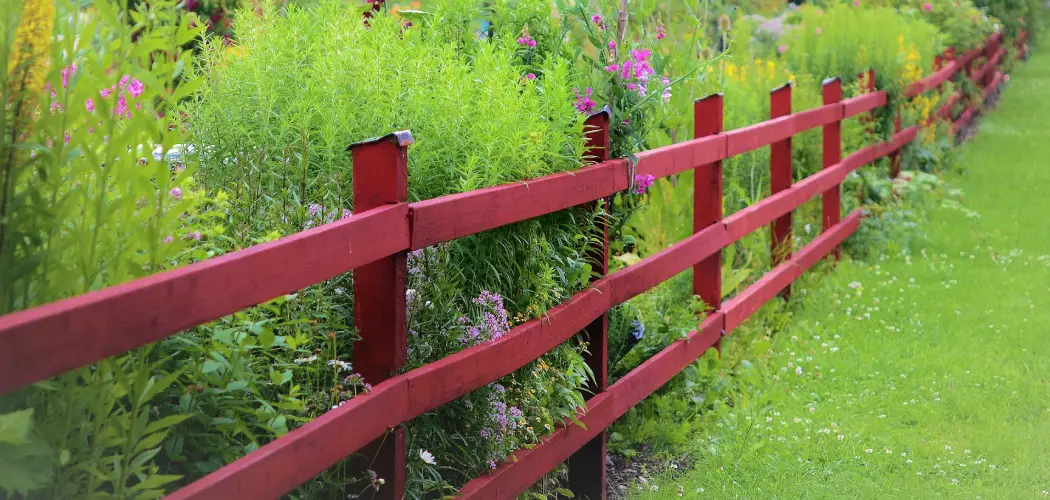Fencing a sloped yard can be tricky, but it is necessary if you want to keep your property secure. It will add an extra layer of protection for your home and family and help maintain the aesthetic appeal of your landscape by providing an attractive boundary for the area. Moreover, installing a fence on a slope will help prevent soil erosion, maintain the natural contours of your land, and provide privacy for you and your family.
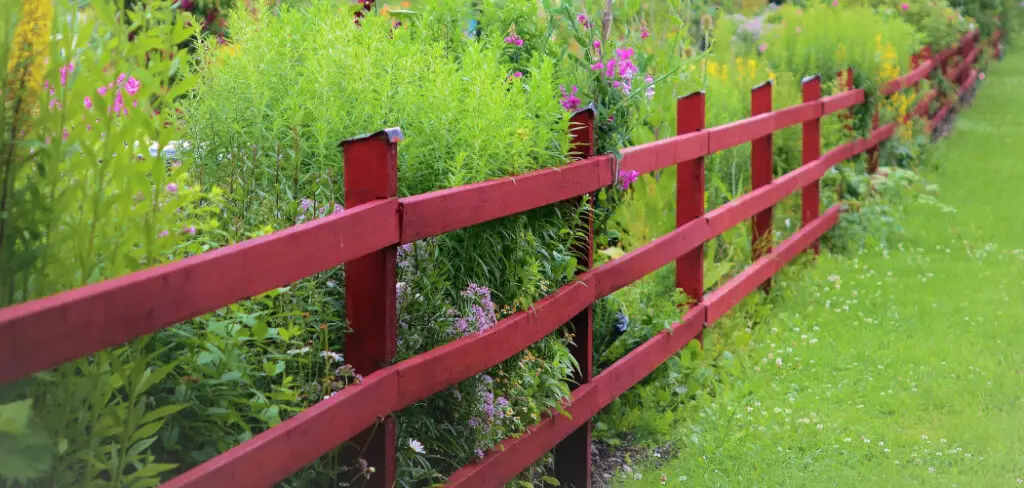
Fencing a sloped yard can bring many advantages. It provides a visual boundary that clearly indicates the property lines and creates an attractive look for any home. Furthermore, it helps keep pets or other animals from wandering off your property. Additionally, it can help protect against soil erosion on your land and provide extra security if needed.
Finally, fencing a sloped yard can also help increase the value of your home and make it more attractive to potential buyers. In this blog post, You will learn in detail how to fence a sloped yard.
Tools or Materials
- Hammer
- Posthole digger
- Level
- Tape measure
- Protractor
- Stakes
- String lines
- Shovel
- Fence posts and brackets
- Fencing material (wood, vinyl, metal)
Step-by-Step Processes for How to Fence a Sloped Yard
Step 1: Inspect the Area
Before starting the project, inspect the area and determine the size of your yard and how much fencing you need. While digging postholes in a sloped yard can be tricky, it is important to measure how far down each hole needs to go for your fence posts to be secure.
Step 2: Calculate the Horizontal Distance Between Posts
The horizontal distance between posts will depend on what type of fence you are installing and how much weight it needs to support. For example, if you are installing a picket fence, your posts don’t need to be as far apart as for a chain link style fence. Measure each post and calculate the overall distance for your entire project.
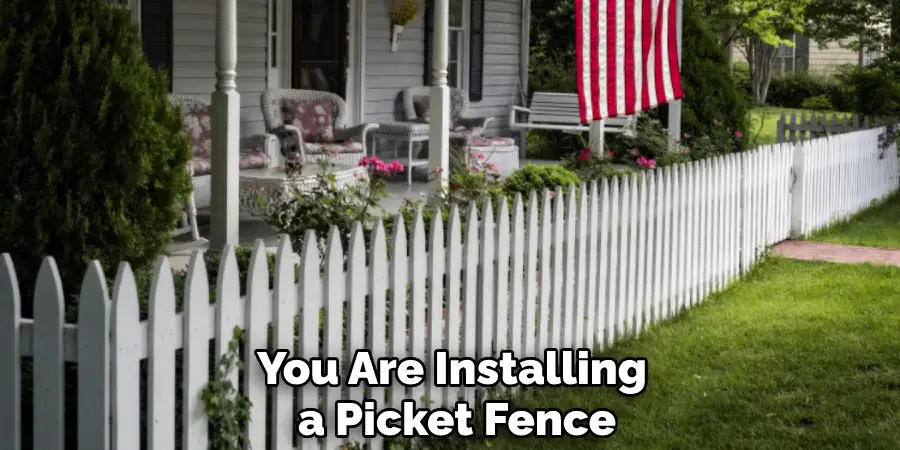
Step 3: Determine How Deep to Dig Postholes
To ensure that your fence is secure, it’s important to dig deep enough postholes so that they reach a firm foundation. If you are digging into rocky terrain or soil with high clay content, you may need to dig deeper than usual. Before beginning the project, determine how deep each posthole needs to be to secure the post.
Step 4: Install Posts in Sloped Yard
Once you’ve determined the size of your yard and calculated the horizontal distance between posts, it’s time to begin installing posts in the sloped yard. Depending on the slope’s steepness, you may need to use a post-hole digger or other specialized tools to help with digging and installation. Make sure that each post is level and secure before moving on to the next one.
Step 5: Secure Fence Panels
Once your posts are all installed, it’s time to secure the fence panels. Depending on your type of fencing, this may involve screws or nails. Make sure that each panel is firmly attached to the post and that there are no gaps between them.
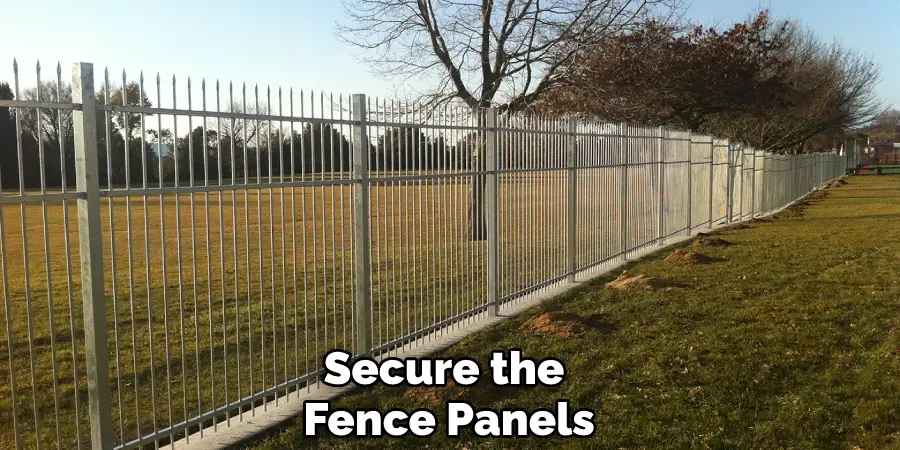
Step 6: Finish Up
Once your panels are in place and secure, it’s time to finish up. Make sure that all screws are tightened, and nails are secured. If you have any extra fencing material, make sure to store it away for future repairs or maintenance.
Tips for How to Fence a Sloped Yard
- For safety, gloves, eyewear, and sturdy boots should always be worn when fencing a sloped yard.
- Post holes should be angled so that the posts lean into the fence line. This helps to keep the fence from sagging due to excessive weight on the downhill side.
- A post brace should be used to help stabilize posts that are installed on sloped terrain. This helps keep the fence from leaning or shifting over time.
- Utilizing heavier materials, such as metal fencing and thicker wooden boards, will ensure added stability and longevity when fencing a sloped yard.
- Before cutting the fence boards to size, make sure that you measure twice and double-check your measurements for accuracy. This will help avoid unnecessary mistakes or having to start all over again due to measurement errors.
- To ensure that the boards are securely attached to the posts, pre-drill holes before installing screws or nails. This will help prevent splitting and ensure a secure bond between the fence post and the board.
- Always wear safety glasses and gloves for protection when using power tools such as a drill or saw. Additionally, ensure the tools are in good working condition, with all safety features engaged.
- When fencing a sloped yard, be sure to stay aware of your surroundings and take caution when using power tools and digging post holes. This will help keep you safe from potential hazards on the work site.
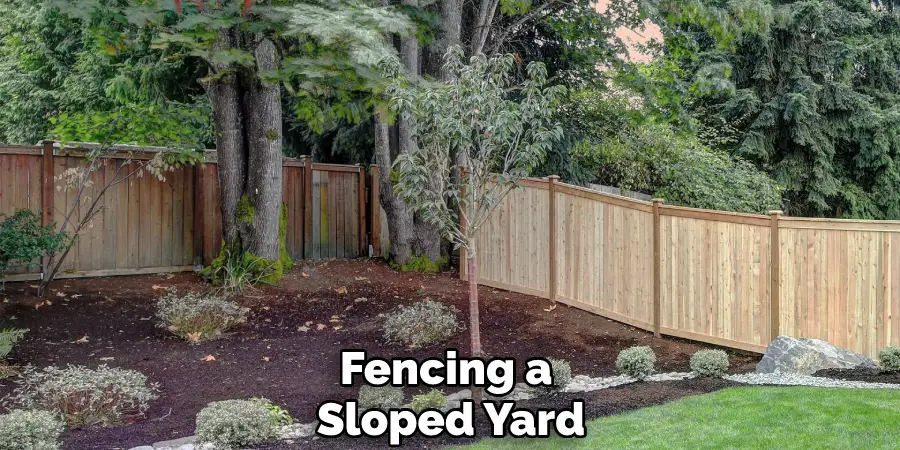
Following these tips will ensure a secure and successful installation when Fencing a Sloped Yard. With the right materials, precautions, and safety measures, you can have peace of mind knowing that your fence is stable and built to last.
How Much Time Should You Allow for the Installation of a Sloped Fence?
The amount of time for the installation of a sloped fence depends on the size and type of the fencing materials being installed. Generally, the full installation can take between an hour to several days. It is important that you allow a generous amount of time for this project because some sections may require special considerations when fencing a sloped yard.
Before beginning this project, measuring the yard accurately and calculating the total materials needed for the job are important. Some sections of the fence may also require additional support for it to stay securely upright when installed on a slope.
This can take more time than normal due to its intricate nature, so be sure to factor this into your timeline. Additionally, if the terrain is uneven or there are a lot of trees and rocks present, it may be necessary to use special tools and techniques for installation in order to ensure stability.
How Often Should You Inspect and Maintain Your Sloped Fence?
- Inspect your fence at least twice a year, once in the spring and again in the fall. This will help you identify any potential problems that need to be addressed before they become serious.
- Check for signs of damage, such as rotting wood, missing or loose boards, and posts that have come away from the ground.
- Check for animals that may have burrowed underneath the fence or chewed through it. If you find any, take steps to fix the problem immediately by either strengthening the fence or trapping and removing the wildlife.
- Trim back any overhanging branches, weeds, or other vegetation growing along the top of your fence. This will help to keep your fence looking neat and give it an extra layer of protection from the elements.
- If your fence is made of wood, make sure you treat it regularly with a water-repellent sealer or paint to protect it from moisture damage and decay.
- Finally, inspect any hardware to secure the fence and ensure all nuts, bolts, and screws are properly tightened. This will help prevent any wobbling or leaning sections of your fence.
By following these steps regularly, you can ensure that your sloped yard is securely fenced and well-maintained at all times. Regular inspection and maintenance allow you to keep your fence looking great and functioning properly for years to come.
How Can You Minimize the Potential for Damage to Your Fence Caused by Weather and Other Elements?

- Clear the Area: Before beginning to build your fence, it is important to clear any debris or large rocks that could cause damage to the fencing material once installed.
- Apply a Protective Coating: You can protect your fence from weathering and decay by applying an acrylic sealant to each piece of wood used for the fence.
- Use Protective Fasteners: Make sure to use stainless steel or galvanized fasteners when installing your fence, as these will not be affected by rust and corrosion caused by moisture.
- Keep Gutters Clean: Cleaning out any debris from rain gutters that may be located near the fencing area can help prevent water damage to the fence.
- Maintain Regular Inspections: Visually inspect your fence regularly, especially after any major weather events, to identify and address any potential issues as soon as possible.
- Store Materials Safely: Ensure that any outdoor storage materials like paint cans or tools are secured and away from the fence to prevent accidental damage.
By following these steps, you can help reduce the potential for weather and other elements to cause damage to your Fencing a Sloped Yard project. With proper maintenance, your fence will remain in good condition for many years to come.
Conclusion
In conclusion, fencing a sloped yard can be tricky, but with the right tools and techniques, it’s definitely doable. When building your fence, always consider the terrain of your lot, as this will impact the type and style of fencing you select.
Also, make sure to research local regulations before beginning work on any fence and enlist professional help when needed. I hope this article has been beneficial for learning how to fence a sloped yard. Make Sure the precautionary measures are followed chronologically.
About
Outdoor Fixes is a distinguished figure in the world of Diy design, with a decade of expertise creating innovative and sustainable Diy solutions.
His professional focus lies in merging traditional craftsmanship with modern manufacturing techniques,
fostering designs that are both practical and environmentally conscious. As the author of diy,
outdoorfixes delves into the art and science of outdoorfixes-making, inspiring artisans and industry professionals alike.
Education RMIT University
(Melbourne, Australia) Associate Degree in Design (Outdoor Fixes) Focus on sustainable design, industry-driven projects,
and practical craftsmanship. Gained hands-on experience with traditional and digital manufacturing tools, such as CAD and CNC software.
Nottingham Trent University
(United Kingdom) Bachelor’s in outdoorfixes.com and Product Design (Honors) Specialized in product design with a focus on blending creativity with production
techniques. Participated in industry projects, working with companies like John Lewis and Vitsoe to gain real-world insights.
Publications and Impact
In diy, Outdoor Fixes his insights on indoor design processes, materials, and strategies for efficient production.
His writing bridges the gap between artisan knowledge and modern industry needs, making it a must-read for both budding designers and seasoned professionals.

